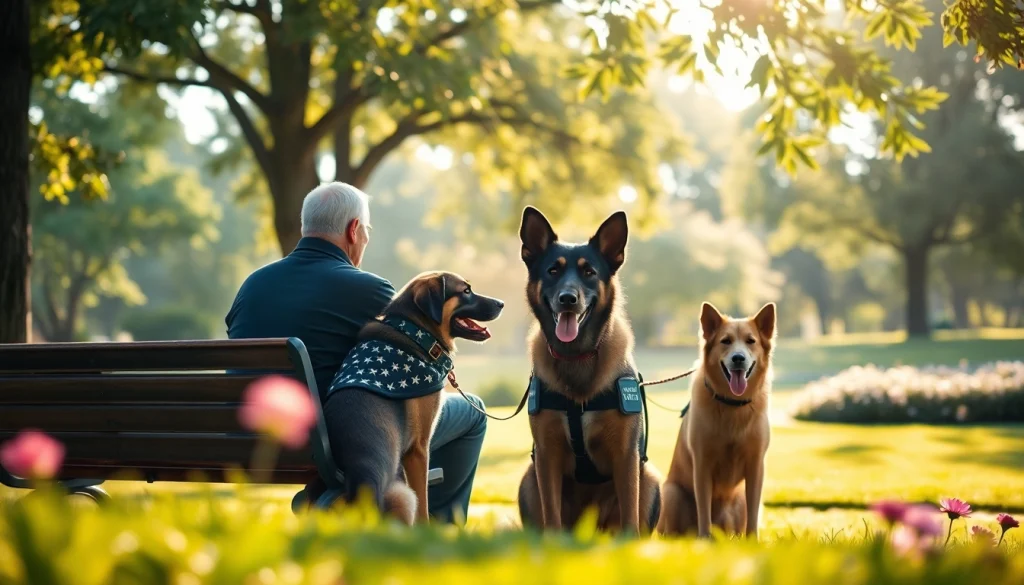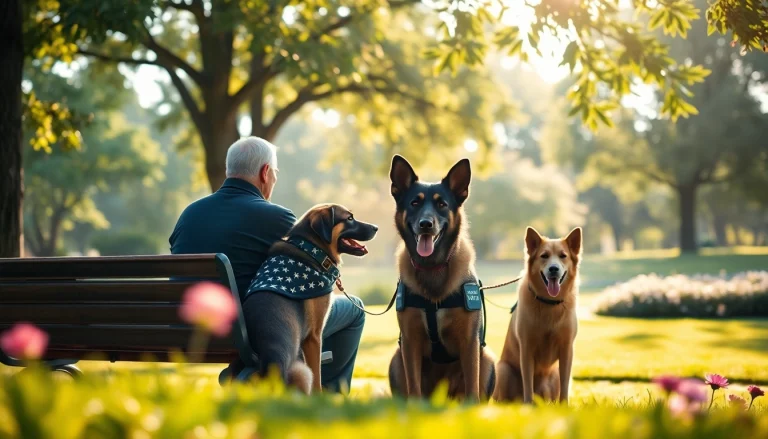
Understanding PTSD and the Role of Service Dogs
What is PTSD and Its Symptoms?
Post-Traumatic Stress Disorder (PTSD) is a mental health condition triggered by experiencing or witnessing a traumatic event. Individuals with PTSD may experience a range of symptoms that can significantly affect their daily lives. Common symptoms include flashbacks, nightmares, severe anxiety, and uncontrollable thoughts about the event. Additionally, physical symptoms such as rapid heartbeat, sweating, and irritability can manifest, making it challenging for individuals to cope with everyday situations.
People suffering from PTSD often find themselves in a cycle of heightened stress and anxiety, leading to difficulties in relationships and daily functioning. Understanding these symptoms is crucial, as it opens the door to seeking appropriate interventions that can help manage and alleviate the impact of PTSD. Among these interventions, PTSD service dogs have emerged as a powerful support tool for many individuals.
How Service Dogs Assist in Managing PTSD Symptoms
Service dogs are specially trained animals that can help individuals with PTSD navigate their symptoms and improve their overall quality of life. These dogs are trained to perform a variety of tasks that can directly alleviate PTSD symptoms. For example, they can be taught to recognize signs of distress in their handler, such as increased heart rates or elevated anxiety levels, and to respond in specific, supportive ways.
Common tasks that PTSD service dogs may perform include:
- Grounding techniques, such as nudging or licking, to redirect the handler’s focus during anxiety attacks.
- Providing deep pressure therapy by laying across the handler’s lap or torso to reduce panic symptoms.
- Creating a physical barrier in social settings to give the individual a sense of safety.
- Alerting the handler to oncoming panic attacks or reminders to take medication.
By recognizing and responding to their handler’s specific needs, PTSD service dogs play a vital role in managing the day-to-day challenges faced by individuals with PTSD.
Types of PTSD Service Dogs and Their Training
Not all service dogs are trained for the same tasks; specialization is essential to effectively assist those with PTSD. Two primary types of service dogs exist for PTSD support:
- Psychiatric Service Dogs: These dogs are trained to assist individuals diagnosed with psychiatric conditions, including PTSD. Their training focuses on providing emotional support and preventing crises.
- Emotional Support Dogs: While not trained to perform specific tasks, these dogs offer companionship and emotional stability. They are not covered under the same legal protections as service dogs but provide significant comfort to their handlers.
Training programs for PTSD service dogs typically involve professional trainers who specialize in canine behavior. Training includes a range of commands and specialized tasks tailored to the unique needs of the handler. Ongoing training and reinforcement are crucial to ensure that the service dog can effectively respond to their handler’s needs in real-life situations.
Benefits of PTSD Service Dogs for Veterans
Emotional Support and Companionship
One of the most significant benefits of having a PTSD service dog is the emotional support and companionship they provide. For veterans dealing with PTSD, feelings of isolation and depression can be particularly profound. A service dog can fill this emotional void, offering unconditional love and companionship that creates a sense of security. Service dogs encourage social interaction, prompting their handlers to engage with the world around them, which can be particularly beneficial in combating feelings of loneliness.
Breaking Barriers and Increasing Independence
PTSD can severely limit a person’s ability to engage in daily activities. Service dogs can help break down these barriers by providing practical support. For instance, the presence of a service dog can make it easier for a veteran to attend social events or public places, significantly enhancing their quality of life and sense of independence.
Additionally, the assistance provided by service dogs fosters greater confidence in their handlers, enabling them to venture into situations they would typically avoid. This newfound independence contributes not only to their mental health but can also significantly impact their ability to reintegrate into civilian life.
Long-Term Improvements in Mental Health
The relationship between a handler and their service dog can lead to long-term mental health improvements for individuals with PTSD. Studies have shown that the presence of service dogs can reduce the severity of PTSD symptoms, lower levels of anxiety, and improve overall emotional health. These benefits extend beyond the immediate relief offered by the service dog; many handlers report sustained improvements in their mental health and quality of life over time.
Choosing the Right PTSD Service Dog
Factors to Consider When Selecting a Service Dog
Selecting the right PTSD service dog is imperative for achieving the desired outcomes. Several factors should be considered in the selection process:
- Temperament: The dog’s temperament is crucial. A calm, gentle, and stable dog is usually best suited for service work, especially for PTSD.
- Size: Depending on the individual’s lifestyle, the size of the dog may be an essential factor. Larger dogs may provide more substantial physical support, while smaller dogs might be easier to manage in public settings.
- Energy Level: Matching the dog’s energy level with the handler’s lifestyle is vital. An active dog may not be suitable for a handler who prefers a calm home environment.
Training Requirements for PTSD Service Dogs
Training requirements for PTSD service dogs can vary significantly. The ideal service dog must undergo extensive training to respond appropriately to their handler’s needs. Most professional organizations require dogs to complete a foundational obedience training program before specializing in tasks for PTSD. Handler education is also essential, as individuals must learn how to work effectively with their service dogs, reinforcing their training and building a strong bond.
Finding Reputable Organizations for Adoption
When searching for a PTSD service dog, finding a reputable organization is crucial. Look for organizations that emphasize positive reinforcement training methods and have a solid track record of successfully pairing service dogs with individuals suffering from PTSD. Investigating the organization’s accreditation, trainer qualifications, and success stories can provide insights into their effectiveness and reliability.
Daily Life with a PTSD Service Dog
Implementing Daily Routines with Your Service Dog
Integrating a PTSD service dog into daily routines can enhance the relationship between the handler and the dog while improving quality of life. Establishing a consistent daily schedule is critical to ensure the dog understands their role and responsibilities. Activities may include regular walks, training sessions, and dedicated playtime, which serve to reinforce the bond and provide necessary exercise for both the handler and the dog.
Handlers should also practice expected routines such as going to the store or attending appointments, gradually introducing different environments to help the dog generalize their training. This process can help minimize anxiety for both the handler and the dog.
Communicating Effectively with Your PTSD Service Dog
Effective communication is key in building a successful partnership with a PTSD service dog. Handlers should be clear and consistent with commands, ensuring that the dog understands what is expected. Using positive reinforcement techniques encourages the dog to respond positively to cues, fostering a healthier relationship.
Handlers should also learn to recognize their dog’s body language, as dogs often communicate their feelings and perceptions through their behavior. Being attuned to these signals allows the handler to respond effectively to their dog’s needs and enhances the collaborative dynamic.
Socializing and Exposing Your Dog to Various Environments
It is essential for PTSD service dogs to be exposed to various environments to ensure they are comfortable and capable of functioning in public spaces. Socialization with other dogs, people, and different settings is critical to a service dog’s training. Handlers can facilitate this by gradually introducing their service dog to new experiences, helping to build confidence and adaptability in diverse circumstances.
Regular outings also serve to reinforce the bond between the handler and the dog, as shared experiences can deepen trust and understanding.
The Future of PTSD Service Dogs
Research and Advancements in Service Dog Training
As the understanding of PTSD evolves, so too does the training for PTSD service dogs. Ongoing research is investigating the most effective training techniques and ways to further the dogs’ ability to assist their handlers. Innovations in training methods aim to further improve the bond and effectiveness of service dogs, ultimately leading to enhanced support for those in need.
Expanding Awareness for PTSD Service Dogs
Raising awareness about the role and significance of PTSD service dogs is crucial for enhancing access to these invaluable resources. As public understanding grows, families, friends, and communities can provide better support for individuals with PTSD. Furthermore, increasing awareness can lead to more funding and resources for training programs and support organizations dedicated to helping those in need.
Community Support and Advocacy for Improved Access
Community support and advocacy play a pivotal role in improving access to PTSD service dogs. Initiatives to enhance funding for training programs, promote legislative measures that ensure service dogs receive the recognition and rights they deserve, and engage the public in understanding the challenges faced by individuals with PTSD can foster a more supportive environment. Collaborative efforts can lead to improved access to service dogs, ultimately transforming lives by providing essential support to those who need it the most.






